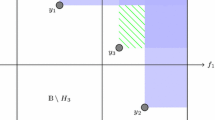Abstract
This paper presents a novel multi-fidelity model-management framework based on the estimated error between the low-fidelity and high-fidelity models. The optimization algorithm is similar to classical multi-fidelity trust-region model-management approaches, but it replaces the trust-radius constraint with a bound on the estimated error between the low- and high-fidelity models. This enables globalization without requiring the user to specify non-intuitive parameters such as the initial trust radius, which have a significant impact on the cost of the optimization yet can be hard to determine a priori. We demonstrate the framework on a simple one-dimensional optimization problem, a series of analytical benchmark problems, and a realistic electric-motor optimization. We show that for low-fidelity models that accurately capture the trends of the high-fidelity model, the developed framework can significantly improve the efficiency of obtaining high-fidelity optima compared to state-of-the-art multi-fidelity optimization methods and a direct high-fidelity optimization.











Similar content being viewed by others
Notes
For all TRMM results, we use the trust-region update parameters \(c_1 = 0.5\), \(c_2 = 2.0\), \(r_1 = 0.1\), \(r_2 = 0.75\), \(\varDelta _0 = 10\), and \(\varDelta _\infty = 10^{3}\varDelta _0\), as recommended by Alexandrov et al. (2001).
Specifically, at each finite-element degree of freedom.
References
Alexandrov NM, Dennis JE, Lewis R, Torczon V (1998) A trust-region framework for managing the use of approximation models in optimization. Struct Optim 15(1):16–23
Alexandrov NM, Lewis R, Gumbert CR, Green LL, Newman PA (2001) Approximation and model management in aerodynamic optimization with variable-fidelity models. J Aircr 38(6):1093–1101
Anderson R, Andrej J, Barker A, Bramwell J, Camier J-S, Cerveny J, Dobrev V, Dudouit Y, Fisher A, Kolev T, Pazner W, Stowell M, Tomov V, Akkerman I, Dahm J, Medina D, Zampini S (2021) MFEM: a modular finite element methods library. Comput Math Appl 81:42–74. https://doi.org/10.1016/j.camwa.2020.06.009
Bryson DE, Rumpfkeil MP (2018) Multifidelity quasi-newton method for design optimization. AIAA J 56(10):4074–4086
Conn Andrew R, Gould Nicholas IM, Toint Philippe L (2000) Trust region methods. SIAM, Philadelphia
Coulomb J (1983) A methodology for the determination of global electromechanical quantities from a finite element analysis and its application to the evaluation of magnetic forces, torques and stiffness. IEEE Trans Magn 19(6):2514–2519. https://doi.org/10.1109/TMAG.1983.1062812. ISSN 1941-0069.
Coulomb J, Meunier G (1984) Finite element implementation of virtual work principle for magnetic or electric force and torque computation. IEEE Trans Magn 20(5):1894–1896. https://doi.org/10.1109/TMAG.1984.1063232. ISSN 1941-0069
Elham A, van Tooren MJL (2017) Multi-fidelity wing aerostructural optimization using a trust region filter-SQP algorithm. Struct Multidisc Optim 55(5):1773–1786
Eriksson D, Jankowiak M (2021) High-dimensional Bayesian optimization with sparse axis-aligned subspaces. In: Uncertainty in artificial intelligence. PMLR, pp 493–503
Eweis-Labolle JT, Oune N, Bostanabad R (2022) Data fusion with latent map Gaussian processes. J Mech Des 144(9):091703
Falgout RD, Yang UM (2002) hypre: a library of high performance preconditioners. In: Sloot PMA, Hoekstra AG, Kenneth Tan CJ, Dongarra JJ (eds) Computational science—ICCS 2002. Springer, Berlin/Heidelberg, pp 632–641. ISBN 978-3-540-47789-1
Fatemi A, Ionel DM, Demerdash NAO, Staton DA, Wrobel R, Chong YC (2019) Computationally efficient strand eddy current loss calculation in electric machines. IEEE Trans Ind Appl 55(4):3479–3489. https://doi.org/10.1109/TIA.2019.2903406. ISSN 1939-9367
Fernández-Godino MG, Park C, Kim N-H, Haftka RT (2016) Review of multi-fidelity models. arXiv Preprint. https://doi.org/10.48550/arXiv.1609.07196
Forrester A, Sóbester A, Keane A (2007) Multi-fidelity optimization via surrogate modelling. Proc R Soc A Math Phys Eng Sci 463(2088):3251–3269
Forrester A, Sóbester A, Keane A (2008) Engineering design via surrogate modelling: a practical guide. Wiley, Hoboken
Foumani ZZ, Shishehbor M, Yousefpour A, Bostanabad R (2023) Multi-fidelity cost-aware Bayesian optimization. Comput Methods Appl Mech Eng 407:115937
Gill PE, Murray W, Saunders MA (2002) SNOPT: an SQP algorithm for large-scale constrained optimization. SIAM J Optim 12(4):979–1006. https://doi.org/10.1137/S1052623499350013
Gill PE, Murray W, Saunders MA (2005) SNOPT: an SQP algorithm for large-scale constrained optimization. SIAM Rev 47(1):99–131. https://doi.org/10.1137/S0036144504446096
Gould NIM, Orban D, Sartenaer A, Toint PL (2005) Sensitivity of trust-region algorithms to their parameters. 4OR 3:227–241
Gratton S, Sartenaer A, Toint PL (2008) Recursive trust-region methods for multiscale nonlinear optimization. SIAM J Optim 19(1):414–444
Gray JS, Hwang JT, Martins JRRA, Moore KT, Naylor BA (2019) OpenMDAO: an open-source framework for multidisciplinary design, analysis, and optimization. Struct Multidisc Optim 59(4):1075–1104. https://doi.org/10.1007/s00158-019-02211-z
Griewank A, Walther A (2008) Evaluating derivatives: principles and techniques of algorithmic differentiation. SIAM, Philadelphia
Haimes R, Dannenhoffer J (2013) The engineering sketch pad: a solid-modeling, feature-based, web-enabled system for building parametric geometry. In: 21st AIAA computational fluid dynamics conference. p 3073. https://doi.org/10.2514/6.2013-3073
Haimes R, Drela M (2012) On the construction of aircraft conceptual geometry for high-fidelity analysis and design. In: 50th AIAA aerospace sciences meeting including the new horizons forum and aerospace exposition. p 683. https://doi.org/10.2514/6.2012-683
Haimes R, Dannenhoffer J, Bhagat ND, Allison DL (2016) Multi-fidelity geometry-centric multi-disciplinary analysis for design. In: AIAA modeling and simulation technologies conference. p 4007. https://doi.org/10.2514/6.2016-4007
Hanselman D (2003) Brushless permanent magnet motor design. Magna Physics Publishing. ISBN 1881855155
Henson VE, Yang UM (2002) BoomerAMG: a parallel algebraic multigrid solver and preconditioner. Appl Numer Math 41(1):155–177. https://doi.org/10.1016/S0168-9274(01)00115-5. ISSN 0168-9274
Hwang JT, Martins JRRA (2018) A computational architecture for coupling heterogeneous numerical models and computing coupled derivatives. ACM Trans Math Softw. https://doi.org/10.1145/3182393. ISSN 0098-3500
Jo Y, Choi S (2014) Variable-fidelity aerodynamic design using gradient-enhanced kriging surrogate model with regression. In: 52nd aerospace sciences meeting. p 0900
Jones DR, Schonlau M, Welch WJ (1998) Efficient global optimization of expensive black-box functions. J Glob Optim 13:455–492
Joseph H, van Bloemen Waanders B (2023) Hyper-differential sensitivity analysis with respect to model discrepancy: optimal solution updating. Comput Methods Appl Mech Eng 412:116082
Keane A (2003) Wing optimization using design of experiment, response surface, and data fusion methods. J Aircr 40(4):741–750
Kennedy GJ, Hicken JE (2015) Improved constraint-aggregation methods. Comput Methods Appl Mech Eng 289:332–354. https://doi.org/10.1016/j.cma.2015.02.017. ISSN 0045-7825
Kennedy MC, O’Hagan A (2001) Bayesian calibration of computer models. J R Stat Soc Ser B (Stat Methodol) 63(3):425–464. https://doi.org/10.1111/1467-9868.00294
Kolev TV (2020) Modular finite element methods. Computer Software. mfem.org
Lewis R (1996) A trust region framework for managing approximation models in engineering optimization. In: 6th symposium on multidisciplinary analysis and optimization. p 4101
March A, Willcox K (2012a) Constrained multifidelity optimization using model calibration. Struct Multidisc Optim 46(1):93–109
March A, Willcox K (2012b) Provably convergent multifidelity optimization algorithm not requiring high-fidelity derivatives. AIAA J 50(5):1079–1089
Martins JRRA, Hwang JT (2013) Review and unification of methods for computing derivatives of multidisciplinary computational models. AIAA J 51(11):2582–2599. https://doi.org/10.2514/1.J052184
Martins JRRA, Ning A (2021) Engineering design optimization. Cambridge University Press, Cambridge
Morris MD, Mitchell TJ, Ylvisaker D (1993) Bayesian design and analysis of computer experiments: use of derivatives in surface prediction. Technometrics 35(3):243–255
Nagawkar J, Ren J, Xiaosong D, Leifsson L, Koziel S (2021) Single-and multipoint aerodynamic shape optimization using multifidelity models and manifold mapping. J Aircr 58(3):591–608
Nocedal J, Wright SJ (1999) Numerical optimization. Springer, New York
Olivanti R, Gallard F, Brézillon J, Gourdain N (2019) Comparison of generic multi-fidelity approaches for bound-constrained nonlinear optimization applied to adjoint-based CFD applications. In: AIAA aviation 2019 forum. p 3102
Peherstorfer B, Willcox K, Gunzburger M (2018) Survey of multifidelity methods in uncertainty propagation, inference, and optimization. SIAM Rev 60(3):550–591
Réthoré P-E, Fuglsang P, Larsen GC, Buhl T, Larsen TJ, Madsen HA (2014) TOPFARM: multi-fidelity optimization of wind farms. Wind Energy 17(12):1797–1816
Shan S, Wang GG (2010) Metamodeling for high dimensional simulation-based design problems. J Mech Des 132(5):051009. https://doi.org/10.1115/1.4001597. ISSN 1050-0472
Shi R, Long T, Ye N, Yufei W, Wei Z, Liu Z (2021) Metamodel-based multidisciplinary design optimization methods for aerospace system. Astrodynamics 5:185–215
Simpson TW, Martins JRRA (2011) Multidisciplinary design optimization for complex engineered systems design: report from an NSF workshop. J Mech Des 133(10):101002. https://doi.org/10.1115/1.4004465
Steinmetz CP (1892) On the law of hysteresis (part II.) and other phenomena of the magnetic circuit. Trans Am Inst Electr Eng IX(1):619–758. https://doi.org/10.1109/T-AIEE.1892.5570469. ISSN 2330-9431
Sullivan CR (2001) Computationally efficient winding loss calculation with multiple windings, arbitrary waveforms, and two-dimensional or three-dimensional field geometry. IEEE Trans Power Electron 16(1):142–150
Viana FAC, Simpson TW, Balabanov V, Toropov V (2014) Special section on multidisciplinary design optimization: metamodeling in multidisciplinary design optimization: how far have we really come? AIAA J 52(4):670–690. https://doi.org/10.2514/1.J052375
Wu N, Kenway G, Mader CA, Jasa J, Martins JRRA (2020) pyOptSparse: a Python framework for large-scale constrained nonlinear optimization of sparse systems. J Open Source Softw 5(54):2564. https://doi.org/10.21105/joss.02564
Wu N, Mader CA, Martins JRRA (2022a) Large-scale multifidelity aerostructural optimization of a transport aircraft. In: 33rd congress of the international council of the aeronautical sciences
Wu N, Mader CA, Martins JRRA (2022b) A gradient-based sequential multifidelity approach to multidisciplinary design optimization. Struct Multidisc Optim 65:131–151. https://doi.org/10.1007/s00158-022-03204-1
Acknowledgements
The authors gratefully acknowledge support for the reported research from the National Aeronautics and Space Administration under the Fellowship Award 20-0091. We graciously thank the authors of Foumani et al. (2023) for providing a data file containing their results to allow easy comparison.
Funding
This study was supported by Glenn Research Center (Grant No. 20-Fellows′20-0091).
Author information
Authors and Affiliations
Corresponding author
Ethics declarations
Conflict of interest
On behalf of all authors, the corresponding author states that there is no conflict of interest.
Replication of results
The code used to implement the E\(^{2}\)M\(^{2}\) algorithm and produce the results presented in Sect. 4.1 can be found on GitHub https://github.com/tuckerbabcock/E2M2.
Additional information
Responsible Editor: Yoojeong Noh
Publisher's Note
Springer Nature remains neutral with regard to jurisdictional claims in published maps and institutional affiliations.
Appendix: Reluctivity model
Appendix: Reluctivity model
We model the reluctivity, \(\nu \left( {\varvec{B}}\right)\), as a piecewise-continuous function where each sub-function of \(\nu\) is based on the material it is in. We use constant values for the reluctivity in the motor’s air-gap, magnets and windings. For the air-gap and motor windings, this function takes the value of the reluctivity of free space \(\nu _{\text {0}} = \frac{1}{\mu _{\text {0}}} = \frac{1}{4 \pi \times 10^{-7}}\). For the magnets, we use the constant value \(\nu _{\text {mag}} = \frac{1}{\mu _{\text {r}} \mu _{\text {0}}}\), where \(\mu _{\text {r}}\) is the magnet’s relative permeability, a material-dependent value listed in a material data-sheets. We take \(\mu _\text {r} = 1.04\) for the \(\text {Nd}_2\text {Fe}_{14}\text {B}\) magnets considered in this work.
The reluctivity of the magnetic steel used in the motor’s stator and rotor is a nonlinear function of the magnetic flux density. We use the model given as follows:
where \(f\left( \Vert {\varvec{B}}\Vert \right)\) is a cubic B-spline that represents the log-transformed reluctivity as a function of the magnitude of the magnetic flux density. The B-spline knot vector and control points are found by minimizing the least-squares error between the spline and discrete \(B\)-\(\nu\) data points. The control points and knot vector for the Hiperco 50 magnetic steel used for the results presented in this work are listed in Table 8.
Rights and permissions
Springer Nature or its licensor (e.g. a society or other partner) holds exclusive rights to this article under a publishing agreement with the author(s) or other rightsholder(s); author self-archiving of the accepted manuscript version of this article is solely governed by the terms of such publishing agreement and applicable law.
About this article
Cite this article
Babcock, T., Hall, D., Gray, J.S. et al. Multi-fidelity error-estimate-based model management. Struct Multidisc Optim 67, 36 (2024). https://doi.org/10.1007/s00158-023-03731-5
Received:
Revised:
Accepted:
Published:
DOI: https://doi.org/10.1007/s00158-023-03731-5




